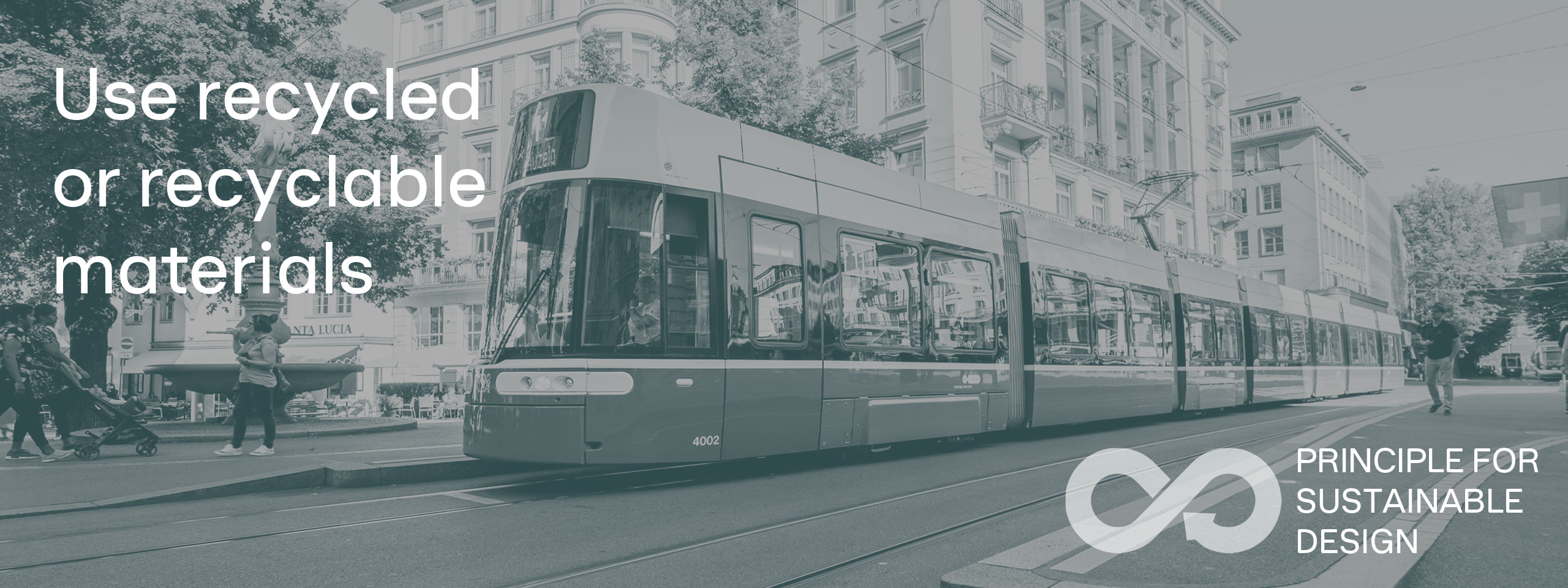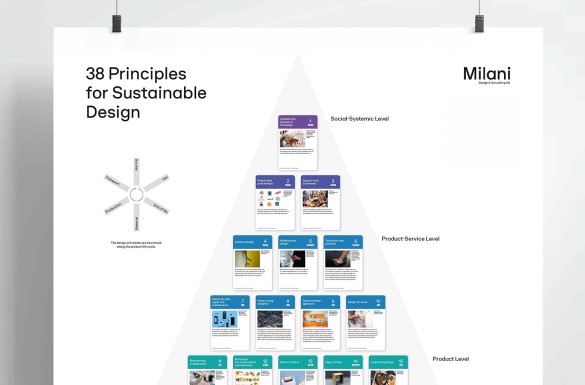38 principles for sustainable design
Sustainable design principle - Use recyclable and recycled materials
Do you want to improve the sustainability of your products? One promising strategy for developing sustainable products is to use reusable and recyclable materials.
In this blog post, Milani presents the principle of sustainable design and practical examples of three companies that apply it successfully .
Sustainable design principle
Use reusable and recycled materials
Briefly explained
The design principle of using reusable and recycled materials aims to extend the useful life of materials and reduce resource consumption.
- Recyclable materials are not thrown away after use, but are returned to the material cycle and reused
- Recycled materials are derived from existing products or materials
Optimally, both criteria are combined to maximize recyclability. In addition, we recommend optimizing the product for disassembly so that it can be easily dismantled and better recycled or reused at the end of its life cycle.
The benefits
Using reusable and recycled materials not only reduces the environmental impact of products, but also has economic benefits.
Companies reduce waste and their need for virgin resources. This is especially beneficial in times of rising commodity prices and scarcity of valuable materials such as industrial metals, precious metals, and rare earths. Materials such as aluminum, steel, glass, and plastics also have the potential to be recycled indefinitely.
By building regional material cycles, companies can also increase their resilience to supply chain disruptions.
Case 1
VBZ relies on reuse and recycling for streetcars and buses
The Flexity Tram of Zurich public transport operator VBZ is the most sustainable tram in Zurich to date. In close collaboration with VBZ and the manufacturer Alstom, Milani developed the interior and exterior design of the new generation of trams. In addition to the use of environmentally friendly technologies and exemplary energy efficiency, the recyclability of materials was a key sustainability aspect: the Flexity consists of 96 percent recyclable materials. With a service life of 40 years, the Flexity is also designed for durability and timeless aesthetics.
VBZ and Milani also used recycled materials for the interior of Zurich's first electric hybrid bus. The seats are upholstered with elegant and hygienic ELeather, which is made from recycled industry leather waste. Production is based on the "nose to tail" principle of the food industry, where all parts of an animal - from nose to tail - are used. The recycled leather seat covers are durable, require less maintenance than fabric covers and need to be replaced less often. Damaged seat covers are not discarded, but made into new ELeather.



Case 2
100% Circular: Napapijri's "Circular Series" clothing collection
The fashion brand Napapijri, known for its high-quality outdoor clothing, has developed the "Circular Series", a collection that is doubly sustainable: the jackets are made from 100% recycled yarn and are 100% recyclable.
A single material is used for all jacket styles, made from discarded fishing nets and other recyclable materials. The use of a single material makes the recycling process much easier. The item can go into the recycling machine without any preparation. The fibers are reprocessed without losing their properties and can be used indefinitely in new Circular Series products.
Napapijri's customers play a key role in the recycling process. If they don't return their jackets, all the potential is wasted. This is why Napapijri offers a convenient take-back service and motivates its customers with a variety of incentives: from free, easy return shipping and exciting discount promotions to targeted communication and awareness campaigns. Customers learn how their returns help reduce the environmental impact of textile production. Napapijri makes the customer experience as pleasant as possible, promoting not only the take-back program but also stronger customer loyalty.
Case 3
Novo Nordisk turns used syringes into furniture and lamps
Do materials have to be recycled for similar products or in the same industry? Far from it! Pharmaceutical company Novo Nordisk is thinking outside the box and breathing new life into used injection pens. In several pilot projects, including in the UK, Denmark and Brazil, patients no longer have to throw away empty injection pens used to treat diabetes, obesity and hormone disorders. Novo Nordisk collects the pens after use through a recycling program. Users can recycle the pens at selected pharmacies, return them via a free recycling box or, in some cases, have them picked up at home. Novo Nordisk disassembles and cleans the used pens. Office chairs are made from the plastic and lamps from the glass.
A major challenge in take-back programs is to scale up the pilot projects to entire countries or regions and make the program profitable. Here, too, Novo Nordisk is a pioneer: In Denmark, Novo Nordisk has joined other pharmaceutical companies and partners in a cross-sector initiative: Return Pen, the national take-back system for injection pens, pools synergies and shares costs. The initiative also involves logistics and operational service providers and is supported by the Danish government and the European Union. Return Pen is still in the pilot phase, but will provide important lessons on how to best scale similar initiatives in the future.
Best practice tips from Milani
To be successful in developing sustainable products using recyclable and reusable materials, we recommend that companies consider the following best practices.
- Design for disassembly: Design the product so that it can be easily disassembled and its components separated
- Reduce the variety of materials or go mono material! Using fewer materials makes the recycling process easier and more cost-effective
- Choose materials that are easy to reuse and recycle
- Think outside the industry box - not only to develop new processes and materials, but also to unlock new business opportunities through the circular economy
- Collaborate with your stakeholders, from suppliers to partners to customers, to understand their needs and challenges
- Rapidly prototype and pilot! An implementation-focused and iterative approach helps you build knowledge and gain insights for later scaling
Blogpost written by Nadine Wolf (Innovation and Business Design)



